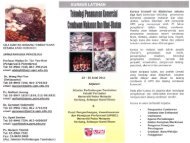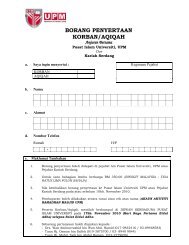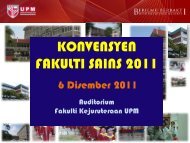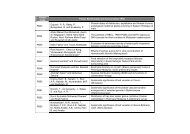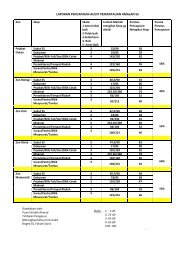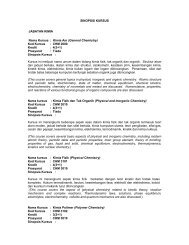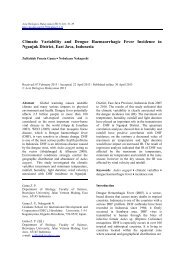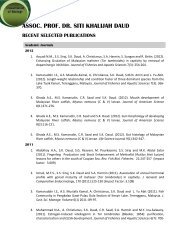Programme Book - UPM - Universiti Putra Malaysia
Programme Book - UPM - Universiti Putra Malaysia
Programme Book - UPM - Universiti Putra Malaysia
Create successful ePaper yourself
Turn your PDF publications into a flip-book with our unique Google optimized e-Paper software.
P21 PHOTOCATALYTIC DEGRADATION OF ORGANIC DYESBY TiO 2 PHOTOCATALYST IMMOBILISED ONTO ITO GLASSZ. Zainal 1,2,* , W.S. Hee 1 , N.A. Awaludin 1 , N.A.A. Rashid 11 Department of Chemistry, Faculty of Science, <strong>Universiti</strong> <strong>Putra</strong> <strong>Malaysia</strong>, 43400<strong>UPM</strong> Serdang, Selangor, <strong>Malaysia</strong>2 Advanced Materials and Nanotechnology Laboratory, Institute of AdvancedTechnology, <strong>Universiti</strong> <strong>Putra</strong> <strong>Malaysia</strong>, 43400 <strong>UPM</strong> Serdang, Selangor, <strong>Malaysia</strong>Corresponding author: zulkar@science.upm.edu.myPhotocatalysis is a promising method in removing dyes from wastewater as thismethod is able to complete mineralization of the target pollutants, into non-toxicsubstances such as CO 2 , water and HCl if chlorinated contaminants are present. Underthe illumination of UV, TiO 2 coated onto glasses have self cleaning, disinfecting andanti-fogging properties. Thus, different techniques (dip coating, brush coating anddoctor blade) were applied to immobilise TiO 2 photocatalyst onto ITO glass in thisstudy. The tested organic dyes were Fast Green, Methylene Blue and Methyl Orangeusing TiO 2 slurry without and with HNO 3 treatment. Simple coating formulationinvolving commercialised TiO 2 powder (Degussa P25), polyethylene glycol (PEG),Triton X, ethanol and deionised water were used in the slurry preparation. Thin filmsamples of TiO 2 /ITO were calcined at 450 o C for 30 minutes. The obtained thin filmswere characterized using linear sweep photovoltammetry, ultraviolet-visiblespectroscopy, X-ray diffractometry, scanning electron microscopy and energydispersive X-ray spectroscopy. Effect of operating parameter towards thephotocatalytic degradation of organic dyes such as coating substrates, number ofcoating layers of TiO 2 onto ITO glass, concentration of TiO 2 , repeated usage ofTiO 2 /ITO thin films and initial concentration of organic dyes were investigated. Nitricacid treated TiO 2 displayed higher photocurrent response than untreated TiO 2 sample.Photocatalytic degradation of the tested organic dyes followed Langmuir–Hinshelwood first-order kinetics. Photocatalytic efficiency also varied with coatingtechniques used. It was found that after three hours of conducting the dye removalprocess, 10 ppm Fast Green was 8.206 ×10 -3 ppm min -1 cm -2 removed by using 15 g%of two dip coated layers of TiO 2 onto ITO glass. Besides, by using four layers of TiO 2brush coated thin film, 2.960 ×10 -3 ppm min -1 cm -2 of 10 ppm Methylene Blue wasremoved in four hours. For 10 ppm of Methyl Orange, it was 3.036 × 10 -3 ppm min -1cm -2 removed in four hours by using two doctor blade coated layers of 15 g % TiO 2 .36 |16 th Industrial Chemistry Seminar: Chemistry- A Passport to a Brighter Future




